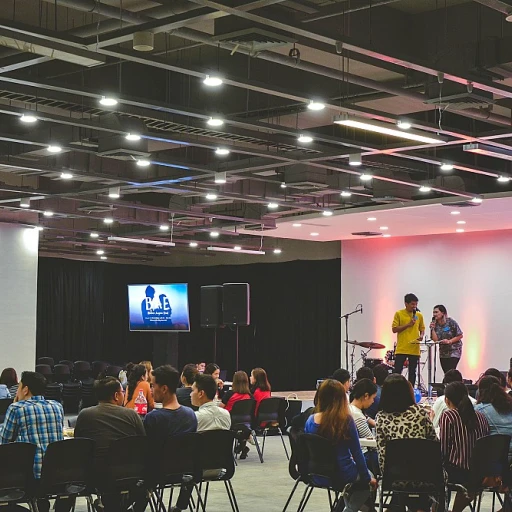
The Role of DEI Training in HR Leadership
Integrating DEI Training into HR Leadership
The integration of Diversity, Equity, and Inclusion (DEI) training into Human Resources leadership is essential for cultivating an inclusive work environment. As a future leader in HR, it's important to recognize the pivotal role that DEI training programs play in shaping the workplace culture and contributing to the overall success of an organization. These training programs are not just about compliance; they are integral to developing an inclusive workplace where employees feel valued and engaged. DEI initiatives help to dismantle unconscious biases, fostering a culture that prioritizes equity inclusion. When effectively integrated, these training programs assist organizations in addressing the complexities of diverse work environments, aiding in both employee engagement and retention. Moreover, as organizations increasingly focus on business sustainability, the role of DEI training becomes even more significant in aligning with corporate goals and values. To gain a deeper understanding of how DEI training fits into HR leadership, especially in terms of supervision and fostering diverse and inclusive environments, consider exploring this insightful resource on the scope of supervision within the Chief Human Resources Officer career. It uncovers the profound linkage between DEI principles and strategic HR leadership roles, highlighting the necessity for comprehensive decision making that embraces diversity and inclusion as core business strategies. Ultimately, embedding DEI training into HR leadership initiatives is a strategic decision that enhances organization-wide culture, promoting an environment where every employee can contribute and thrive. This focus on diversity inclusion and equity ultimately results in a stronger, more cohesive organization.Key Components of Effective DEI Training
Key Elements for a Comprehensive Learning Approach
Diversity, equity, and inclusion (DEI) training has become essential for cultivating an inclusive workplace environment. To achieve effective DEI programs, it is crucial to focus on certain core elements that ensure comprehensive learning experiences for all employees.
Structured Training Programs
- Understanding Unconscious Bias: Employees become aware of inherent biases that might affect their attitudes and decision-making processes. Such recognition helps in fostering a more equitable work culture.
- Diverse and Inclusive Content: Engaging training content that reflects varied perspectives ensures all individuals feel represented and valued within the organization.
- Interactive Learning: Workshops and role-playing exercises enhance understanding and allow employees to practice inclusive leadership skills in real-time scenarios.
Emphasizing Culture and Employee Engagement
As organizations prioritize diverse work environments, a key component of DEI training is promoting a culture that actively engages employees. By incorporating DEI initiatives that resonate with the unique needs of the workforce, businesses can cultivate greater employee commitment and loyalty.
- Inclusive Decision-Making: Empower employees by involving them in organizational decisions, thus creating a stronger connection to company goals and values.
- Regular Feedback Mechanisms: Establishing channels for open communication and feedback ensures that the DEI training remains relevant and adapts to changing employee needs.
If you're interested in a deeper understanding, explore this link relating to the strategies of integrating technology and DEI training in HR leadership for a progressive organization.
Challenges in Implementing DEI Training
Diverse Challenges in Implementing DEI Training
Implementing diversity, equity, and inclusion training in the workplace is crucial for fostering an inclusive culture within organizations. However, HR leaders often face numerous challenges while initiating these training programs. Understanding and navigating these obstacles is essential for creating an effective DEI framework. One major challenge is overcoming unconscious bias, which can deeply affect decision making and workplace dynamics. These biases may be deeply ingrained in the organizational culture, making it difficult to address them effectively. Training programs focusing on recognizing and mitigating such biases are pivotal but require thoughtful execution. Another significant hurdle is ensuring employee engagement in DEI initiatives. Employees might perceive these programs as a formality rather than genuine efforts towards inclusive leadership. To combat this, it helps to incorporate interactive elements in training, enabling employees to connect personally with the diversity equity and inclusion objectives. This approach not only engages employees but also creates a sense of shared responsibility in the business. Moreover, resource constraints in terms of time and budget can pose a barrier. Organizations often have limited capacity to invest in comprehensive DEI training, especially when striving to balance with other learning and development commitments. To address this issue, HR professionals need to advocate for these programs as integral to the overall organizational strategy, highlighting their long-term benefits for improving workplace culture. Lastly, measuring the impact of DEI training can be challenging. Without clear metrics and evaluation methods, it’s difficult to ascertain the effectiveness of the training and its subsequent contribution to an inclusive workplace. Implementing structured feedback mechanisms and continuous improvement loops can be beneficial in assessing progress and making necessary adjustments. As businesses continue to evolve, the need for training helps address diversity inclusion challenges becomes more pressing. Successful DEI training requires commitment, adaptability, and a clear understanding of the unique needs within each organization. Further insights on how to implement successful training programs can be explored through the succession management in HR leadership.Measuring the Impact of DEI Training
Evaluating the Success of DEI Initiatives
Measuring the impact of DEI training is crucial for organizations aiming to foster an inclusive workplace. It helps in understanding how effective DEI initiatives are in promoting diversity, equity, and inclusion within the workplace culture. To assess the success of these training programs, organizations need to consider various metrics and feedback mechanisms.
Key Metrics for Assessing DEI Training
- Employee Feedback: Gathering insights from employees through surveys and interviews can provide valuable information on how DEI training has influenced their perception of the workplace. Employees' feelings about inclusion and equity can be a direct indicator of the training's effectiveness.
- Diversity Metrics: Tracking changes in the diversity of the workforce over time can help organizations understand if their DEI training is contributing to a more diverse and inclusive environment.
- Engagement Levels: An increase in employee engagement often correlates with successful DEI initiatives. Engaged employees are more likely to feel valued and included, which can be a sign of effective DEI training.
- Retention Rates: A decrease in turnover rates among diverse employees can indicate that DEI training is helping to create a more supportive and inclusive work environment.
Challenges in Measuring DEI Impact
Despite the importance of measuring DEI training outcomes, organizations often face challenges in doing so. One major hurdle is the complexity of quantifying cultural changes and shifts in employee attitudes. Additionally, unconscious bias can skew perceptions and feedback, making it difficult to obtain accurate assessments.
To overcome these challenges, organizations should employ a combination of qualitative and quantitative methods. Regularly reviewing and adjusting DEI training programs based on feedback and data can help ensure they remain effective and relevant.
DEI Training and Employee Engagement
Fostering a Sense of Belonging Through DEI Training
A truly inclusive workplace goes beyond mere policies and procedures; it requires a concerted effort to establish an environment where all employees feel valued and respected. DEI training plays a crucial role in achieving this objective by creating a culture of acceptance and understanding within the organization. Effective DEI initiatives help in breaking down barriers of unconscious bias, enabling a diverse workforce to thrive. By implementing proactive diversity, equity, and inclusion training programs, organizations can cultivate an inclusive culture that enhances employee engagement. Employees tend to feel more invested in their work environment when they see that their organization is committed to equity and inclusive leadership. This alignment often results in increased job satisfaction, productivity, and retention. Moreover, DEI training helps organizations to recognize and appreciate the unique perspectives and strengths of a diverse workforce. This variety in viewpoints can lead to more innovative decision making and problem-solving. In fostering a work environment where every individual feels their contributions are valued, companies are better able to harness the full potential of their employees. In conclusion, prioritizing DEI training within an organization not only reflects a commitment to fairness and equality but also creates a more engaged and motivated workforce. As businesses continue to adapt and grow, embracing diversity and inclusion as key organizational values is imperative for long-term success.Future Trends in DEI Training for HR Professionals
Emerging Trends in DEI Training for HR Professionals
As organizations continue to prioritize diversity, equity, and inclusion (DEI) in the workplace, the landscape of DEI training is evolving. HR professionals, especially those aspiring to become Chief Human Resources Officers, need to stay ahead of these trends to effectively lead DEI initiatives. Here are some key trends shaping the future of DEI training:
- Personalized Learning Experiences: Training programs are increasingly tailored to meet the specific needs of diverse employee groups. This approach helps create a more inclusive learning environment where employees feel valued and understood.
- Integration of Technology: Virtual reality and AI are being used to simulate real-world scenarios, allowing employees to experience situations involving unconscious bias and decision making in a safe space. This technology-driven approach enhances engagement and retention of DEI principles.
- Focus on Inclusive Leadership: Training programs are emphasizing the development of inclusive leadership skills. This shift helps leaders at all levels foster a culture of equity and inclusion, which is crucial for a diverse workforce.
- Continuous Learning and Development: Rather than one-time workshops, organizations are adopting ongoing DEI training programs. This continuous approach ensures that DEI principles are embedded in the organizational culture and decision-making processes.
- Measurement and Accountability: As discussed in previous sections, measuring the impact of DEI training is critical. Future programs will likely include more robust metrics to assess effectiveness and hold leaders accountable for progress.
These trends highlight the dynamic nature of DEI training and its importance in creating an inclusive workplace. By embracing these changes, HR professionals can effectively lead their organizations towards a more equitable and diverse future.












